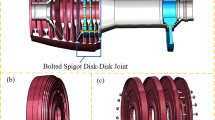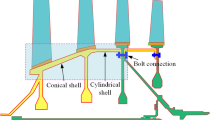Abstract
Purpose
In this paper, the spigot bolted connection structure is taken as the research object, and its nonlinear stiffness characteristics are studied, focusing on revealing the influence of the spigot on the overall stiffness characteristics of the connection structure. On this basis, the influence of the stiffness change of the bolt connection on the dynamic characteristics of the rotor system is analyzed.
Methods
The nonlinear stiffness characteristics of bolted connection structures are studied from the aspects of stress–strain analysis and finite-element numerical simulation in different stages of the structure, and the equivalent models of bending stiffness and radial stiffness are established. The finite-element model of the rotor is established using the six-degree-of-freedom Timoshenko beam element. The Newmark-β method is used to calculate the vibration response of the rotor system considering the nonlinear stiffness of the bolt connection structure.
Results
Under different tensile loads, the spigot bolted connection structure can be divided into three deformation states: spigot viscous state, front flange separation of bolt, and rear flange separation of bolt. The force on the structure is different under different deformation states, resulting in piecewise tensile stiffness nonlinear characteristics; the overall bending stiffness shows an “inverted S” shape nonlinear change law. The rotor dynamic characteristics of the spigot bolted connection structure: under small unbalance, the nonlinear characteristics of bending stiffness have not been excited, the rotor vibration is periodic vibration; under large unbalance, the nonlinear characteristics of bending stiffness are excited, and the rotor presents a complex quasi-periodic motion in a certain speed range.
Conclusion
The force on the spigot bolted connection structure is different under different deformation states, resulting in piecewise tensile stiffness nonlinear characteristics; the overall bending stiffness shows an “inverted S” shape nonlinear change law. The rotor unbalance mainly affects the excitation of the nonlinear characteristics of the bending stiffness, as the unbalance increases, the quasi-periodic vibration area moves backward, and the speed range narrows.



































Similar content being viewed by others
Data Availability
The data that support the findings of this study are available from the corresponding author upon reasonable request.
References
Liu SG, Ma YH, Zhang D, Hong J (2012) Studies on dynamic characteristics of the joint in the aero-engine rotor system. Mech Syst Signal Process 29:120–136. https://doi.org/10.1016/j.ymssp.2011.12.001
Yu W, Mei Q, Zhang DY, Hong J (2017) Robust design method of rabbet joint structure in high speed assemble rotor. J Aerospace Power 32(7):1754–1761
Hong J, Yu PC, Ma YH, Zhang DY (2020) Investigation on nonlinear lateral-torsional coupled vibration of a rotor system with substantial unbalance. Chin J Aeronaut 33(6):1642–1660. https://doi.org/10.1016/j.cja.2020.02.023
Ouyang H, Oldfield MJ, Mottershead JE (2006) Experimental and theoretical studies of a bolted joint excited by a torsional dynamic load. Int J Mech Sci 48(12):1447–1455. https://doi.org/10.1016/j.ijmecsci.2006.07.015
Argatov I, Butcher EA (2011) On the Iwan models for laptype bolted joints. Int J Nonlinear Mech 46(2):347–356. https://doi.org/10.1016/j.ijnonlinmec.2010.09.018
Schwingshackl CW, Petrov EP (2012) Modeling of flange joints for the nonlinear dynamic analysis of gas turbine engine casings. J Eng Gas Turbines Power 134(12):122504.1-122504.4. https://doi.org/10.1115/1.4007342
Yang XY, Wang JJ (2017) Effects of load and structure parameters of aero-engine bolted joints on joint stiffness. J Propuls Technol 38(2):424–433
Nizametdinov FR, Romashin YS, Berne AL, Leontyev NK (2020) Investigation of bending stiffness of gas turbine engine rotor flanged connection. J Mech 36(6):729–736. https://doi.org/10.1017/jmech.2020.14
Luan Y, Guan ZQ, Cheng GD, Liu S (2012) A simplified nonlinear dynamic model for the analysis of pipe structures with bolted flange joints. J Sound Vib 331(2):325–344. https://doi.org/10.1016/j.jsv.2011.09.002
Wang C, Zhang D, Zhu X, Jie H (2014) Study on the stiffness loss and the dynamic influence on rotor system of the bolted flange joint. ASME paper GT2014-26191
Wang KP, Yan M, Su DH, Sun ZQ (2023) Bolt loosening characteristics based on change of slip-adhesion contact state under shear load. J Aerospace Power 38(2):453–361. https://doi.org/10.13224/j.cnki.jasp.20210127
Liu Y, Zhao DW, Guo XB, Ai YT (2023) Stiffness and geometry characteristics of flange connection with bolt failure and its influence on rotor dynamics. Proc Inst Mech Eng C J Mech Eng Sci 237(17):3838–3849. https://doi.org/10.1177/09544062221147405
Qin ZY, Han QK, Chu FL (2016) Bolt loosening at rotating joint interface and its influence on rotor dynamics. Eng Fail Anal 59:456–466. https://doi.org/10.1016/j.engfailanal.2015.11.002
Beaudion MA, Behdinan K (2019) Analytical lump model for the nonlinear dynamic response of bolted flanges in aero-engine casings. Mech Syst Signal Process 115:14–28. https://doi.org/10.1016/j.ymssp.2018.05.056
Tang QS, Li CF, She HX, Wen BC (2019) Nonlinear response analysis of bolted joined cylindrical–cylindrical shell with general boundary condition. J Sound Vib 443:788–803. https://doi.org/10.1016/j.jsv.2018.12.003
Meng CX, Zhang WS, Ma H, Qin ZY, Fan FY (2019) Analysis of dynamic characteristics of a bolted drum rotor structure. J Vib Eng 32(3):517–525. https://doi.org/10.16385/j.cnki.issn.1004-4523.2019.03.017
Liu ZQ, Cao SQ, Guo HL, Li LQ (2016) Vibration characteristics of rotor systems with bolt joints. J Vib Shock 35(22):10–37. https://doi.org/10.13465/j.cnki.jvs.2016.22.002
Liu Y, Liu H, Li Y, Wang NS (2021) Dynamic modeling and nonlinear characteristics of a cracked bolt-disc combined rotor system. J Eng Gas Turbines Power Trans ASME 2021(9):143. https://doi.org/10.1115/1.4051415
Yue C, Zheng X, Wang C, Liu H, Chen H (2023) Modeling and identification method of bolt loosening of joint surface under axial tension of multistage disc-drum rotor. Eksploatacja i Niezawodność Mainten Reliab 25(2):165779. https://doi.org/10.17531/ein/165779
Wang L, Liu HT, Zhang J, Zhao WH (2013) Analysis and modeling for flexible joint interfaces under micro and macro scale. Precis Eng 37(4):817–824. https://doi.org/10.1016/j.precisioneng.2013.03.008
Johnson KL (1986) Contact mechanics. Tribology 19(2):109–110. https://doi.org/10.1016/0301-679X(86)90085-X
Zhang QC, Li WX, Liang ZC, Hong J (2014) Study on the stiffness loss and its affecting factors of the spline joint used in rotor systems. ASME turbo expo: turbine technical conference and exposition. Am Soc Mech Eng 7:11. https://doi.org/10.1115/GT2014-26176
Funding
This work was supported by the National Natural Science Foundation of China (Grant No. 52272436) and National Science and Technology Major Project (J2019-IV-004-0071).
Author information
Authors and Affiliations
Corresponding author
Ethics declarations
Conflict of interest
The authors declare that they have no conflict of interest.
Additional information
Publisher's Note
Springer Nature remains neutral with regard to jurisdictional claims in published maps and institutional affiliations.
Rights and permissions
Springer Nature or its licensor (e.g. a society or other partner) holds exclusive rights to this article under a publishing agreement with the author(s) or other rightsholder(s); author self-archiving of the accepted manuscript version of this article is solely governed by the terms of such publishing agreement and applicable law.
About this article
Cite this article
Shen, X., Chen, G. Rotor Vibration Characteristics Considering Nonlinear Stiffness of Spigot Bolts. J. Vib. Eng. Technol. 12, 6703–6721 (2024). https://doi.org/10.1007/s42417-024-01279-2
Received:
Revised:
Accepted:
Published:
Issue Date:
DOI: https://doi.org/10.1007/s42417-024-01279-2




